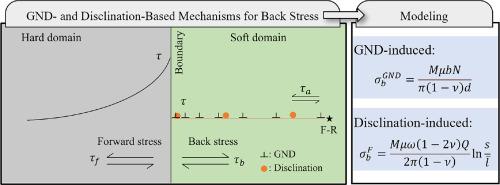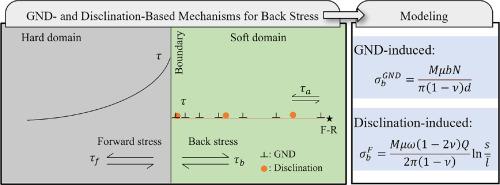一种强调应变硬化中斜向反应力的新本构模型
IF 12.8
1区 材料科学
Q1 ENGINEERING, MECHANICAL
引用次数: 0
摘要
背应力硬化是塑性变形过程中应变硬化的一个组成部分。传统的位错理论将多晶金属材料中背应力的微观来源归因于几何必要位错(GNDs)产生的远程应力场,这种应力场适应了晶体的平动晶格不相容。然而,晶格不相容也包含一个旋转分量,与偏斜有关。与GNDs类似,斜向也会产生长期的内部应力场,但它们在背应力中的作用仍未得到充分的了解。本研究引入斜交引起的背应力机制,并提出了一种新的单端斜交堆积模型,类似于单端GND堆积模型。该模型解释了由于晶粒内偏斜的生长而导致的远程应力场平均距离的减小。综合GNDs和disations的背应力贡献,建立了一个新的本构模型。对6061-T5铝合金板进行了单轴拉伸仿真,结果表明,该模型预测的背应力与拉伸压缩试验结果吻合较好,验证了该模型的准确性。模拟结果表明,gnd诱导的背应力先快速增大后趋于稳定,而斜斜诱导的背应力持续上升,在应变为0.16时占总背应力的65%。这项工作不仅促进了我们对斜向中背应力起源的理解,而且强调了将斜向纳入背应力计算的重要性,为微观结构演变与应变硬化行为之间的关系提供了新的见解。本文章由计算机程序翻译,如有差异,请以英文原文为准。


A novel constitutive model emphasizing disclination-induced back stress in strain hardening
Back stress hardening is a component of strain hardening during plastic deformation. Traditionally, the theory of dislocations has attributed the microscopic origin of back stress in polycrystalline metal materials to the long-range stress fields generated by geometrically necessary dislocations (GNDs), which accommodate the translational lattice incompatibility of the crystal. However, the lattice incompatibility also contains a rotational component, associated with disclinations. Similar to GNDs, disclinations also generate long-range internal stress fields, yet their role in back stress remains insufficiently understood. This study introduces a disclination-induced back stress mechanism and proposes a novel single-ended disclination pile-up model, analogous to the single-ended GND pile-up model. This model accounts for the reduction in the average distance of long-range stress fields due to the growth of disclinations within grains. Integrating back stress contributions from both GNDs and disclinations, a new constitutive model is developed. Uniaxial tension simulations of 6061-T5 aluminum alloy sheets demonstrate that the predicted back stress from this model closely aligns with experimental results from tension-compression tests, thereby validating its accuracy. The simulation results show that while GND-induced back stress rapidly increases initially and then stabilizes, disclination-induced back stress continues to rise, constituting 65% of the total back stress at a strain of 0.16. This work not only advances our understanding of the origins of back stress in disclinations but also underscores the significance of incorporating disclinations in back stress calculations, offering new insights into the relationship between microstructure evolution and strain hardening behavior.
求助全文
通过发布文献求助,成功后即可免费获取论文全文。
去求助
来源期刊

International Journal of Plasticity
工程技术-材料科学:综合
CiteScore
15.30
自引率
26.50%
发文量
256
审稿时长
46 days
期刊介绍:
International Journal of Plasticity aims to present original research encompassing all facets of plastic deformation, damage, and fracture behavior in both isotropic and anisotropic solids. This includes exploring the thermodynamics of plasticity and fracture, continuum theory, and macroscopic as well as microscopic phenomena.
Topics of interest span the plastic behavior of single crystals and polycrystalline metals, ceramics, rocks, soils, composites, nanocrystalline and microelectronics materials, shape memory alloys, ferroelectric ceramics, thin films, and polymers. Additionally, the journal covers plasticity aspects of failure and fracture mechanics. Contributions involving significant experimental, numerical, or theoretical advancements that enhance the understanding of the plastic behavior of solids are particularly valued. Papers addressing the modeling of finite nonlinear elastic deformation, bearing similarities to the modeling of plastic deformation, are also welcomed.
 求助内容:
求助内容: 应助结果提醒方式:
应助结果提醒方式:


